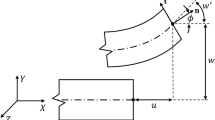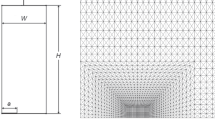Abstract
A new three-dimensional crack tip element is proposed, which is based on a mixed hybrid stress/displacement model. A truncated series expansion of eigenfunctions for the straight semi-infinite crack is deduced and assumed for the internal stress and displacement fields in the element. The basic approach of constructing these hybrid elements is outlined. Their good capability, efficiency and accuracy for analyzing three-dimensional elastic crack problems are demonstrated by first numerical examples.
Résumé
On propose un nouveau type d'élément tridimensionnel pour l'extrémité d'une fissure, basé sur un modèle mixte contraintes hybrides/déplacements. On en tire un développement en séries tronquées des eigenfonctions relatives à une fissure droite semi-infinie, et on suppose qu'elle est représentative des champs de contraintes internes et de déplacements dans l'élément. L'approche de base utilisée pour construire ces éléments hybrides est soulignée. On démontre par de premiers exemples numériques qu'ils ont la capacité, l'efficacité et la précision nécessaires à l'analyse des problèmes élastiques et tridimensionnels de fissuration.
Similar content being viewed by others
References
S.N. Atluri, Computational Methods in the Mechanics of Fracture, North-Holland, Amsterdam (1985).
P. Tong, T.H.H. Pian and S.J. Lasry, International Journal of Numerical Methods in Engineering 7 (1973) 297–308.
M. Kuna, in Numerical Methods in Fracture Mechanics, A.R. Luxmoore (ed.), Pineridge Press, Swansea (1978) 537–549.
H.G. Maschke and M. Kuna, Theoretical and Applied Fracture Mechanics 4 (1985) 181–189.
S.N. Atluri and K. Kathiresan, Nuclear Engineering and Design 51 (1979) 163–176.
T.H.H. Pian and K. Moriya, in Numerical Methods in Fracture Mechanics, Pineridge Press, Swansea (1978). 363–373.
M. Kuna, in Application of Fracture Mechanics to Materials and Structures, G.C. Sih (ed.), Freiburg (1983) 607–618.
R.J. Hartranft and G.C. Sih, Journal of Mathematics and Mechanics 19 (1969) 123–138.
M. Zwicke, Ein gemischtes Hybridelement für dreidimensionale Rissprobleme, Research Report IFE Halle (1985).
M. Kuna, J. Altenbach and M. Zwicke, in VII Symposium Deformation and Fracture, Magdeburg (1985) 197–202.
R. Drumm, Zur effektiven FEM-Analyse ebener Spannungskonzentrationsprobleme, Thesis, University Karlsruhe (1982).
H. Tada, P.C. Paris and G.R. Irwin, The Stress Analysis of Cracks, Hellertown, Pennsylvania (1973).
Y. Yamamoto and Y. Sumi, International Journal of Fracture 14 (1978) 17–38.
J.P. Benthem and W.T. Koiter, in Mechanics of Fracture I, G.C. Sih (ed.), Noordhoff, Leyden (1973) 131–178.
O.L. Bowie, in Mechanics of Fracture I, G.C. Sih (ed.), Noordhoff, Leyden (1973) 1–55.
Z.P. Bazant and L.F. Estenssoro, International Journal of Solids and Structures 15 (1979) 405–426.
Author information
Authors and Affiliations
Rights and permissions
About this article
Cite this article
Kuna, M., Zwicke, M. A mixed hybrid finite element for three-dimensional elastic crack analysis. Int J Fract 45, 65–79 (1990). https://doi.org/10.1007/BF00012610
Received:
Accepted:
Issue Date:
DOI: https://doi.org/10.1007/BF00012610




